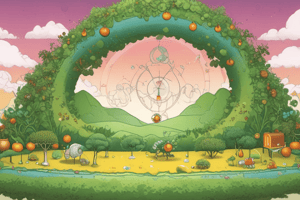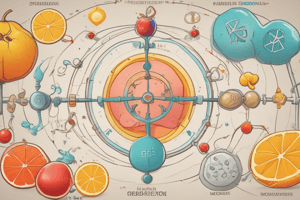Podcast
Questions and Answers
Where does glycolysis occur in a cell?
Where does glycolysis occur in a cell?
- Lysosome
- Mitochondria
- Nucleus
- Cytosol (correct)
What is the result of glycogen breakdown?
What is the result of glycogen breakdown?
- Glucose is converted into glycogen
- Glycogen is converted into glucose (correct)
- Glucose is converted into pyruvate
- Pyruvate is converted into acetyl-CoA
What is the role of acetyl-CoA in the citric acid cycle?
What is the role of acetyl-CoA in the citric acid cycle?
- It is the starting material for the citric acid cycle (correct)
- It is converted into succinyl-CoA in the citric acid cycle
- It is the final product of the citric acid cycle
- It is not involved in the citric acid cycle
How many ATP molecules are generated directly in the citric acid cycle?
How many ATP molecules are generated directly in the citric acid cycle?
What is the byproduct of pyruvate oxidation?
What is the byproduct of pyruvate oxidation?
What is the name of the cycle that generates ATP, NADH, and FADH2 molecules?
What is the name of the cycle that generates ATP, NADH, and FADH2 molecules?
Flashcards are hidden until you start studying
Study Notes
Glucose Metabolism
Glycolysis
- Converts glucose (6-carbon sugar) into pyruvate (3-carbon molecule)
- Occurs in cytosol of cells
- Generates 2 ATP and 2 NADH molecules
- Can occur in absence of oxygen (anaerobic) or presence of oxygen (aerobic)
Pyruvate Oxidation
- Converts pyruvate into acetyl-CoA
- Occurs in mitochondria
- Generates 2 NADH molecules
- Acetyl-CoA enters citric acid cycle
Glycogen Synthesis and Breakdown
- Glycogen is a stored form of glucose in liver and muscles
- Glycogen synthesis: glucose is converted into glycogen
- Glycogen breakdown: glycogen is converted into glucose
- Regulated by hormones (insulin and glucagon)
Citric Acid Cycle (Krebs Cycle or Tricarboxylic Acid Cycle)
Overview
- Also known as Krebs cycle or tricarboxylic acid (TCA) cycle
- Occurs in mitochondria
- Generates ATP, NADH, and FADH2 molecules
Steps
- Acetyl-CoA is converted into citrate
- Citrate is converted into isocitrate
- Isocitrate is converted into α-ketoglutarate
- α-Ketoglutarate is converted into succinyl-CoA
- Succinyl-CoA is converted into succinate
- Succinate is converted into fumarate
- Fumarate is converted into malate
- Malate is converted into oxaloacetate
- Oxaloacetate is converted into citrate, repeating the cycle
Products
- ATP: 2 molecules generated directly
- NADH: 6 molecules generated
- FADH2: 2 molecules generated
- Coenzyme A (CoA): regenerated for reuse
Studying That Suits You
Use AI to generate personalized quizzes and flashcards to suit your learning preferences.




